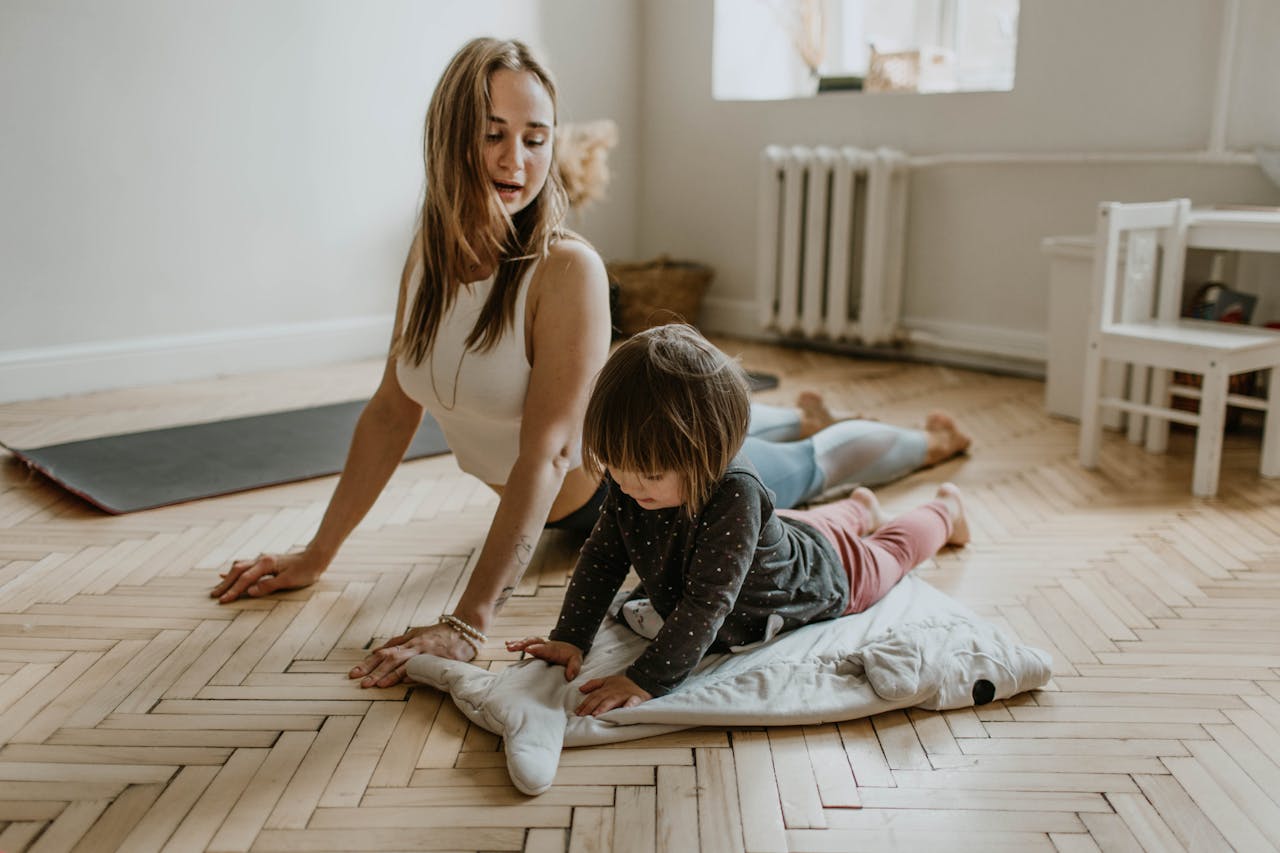Rainy days don’t have to mean screen time marathons or restless kids bouncing off the walls. As a pediatrician, I’ve seen how consistent, developmentally appropriate indoor activity can bolster cardiovascular health, strengthen muscles, and even improve mood and sleep quality in children. In this comprehensive guide, you’ll discover pediatrician-approved indoor exercise ideas and learn how to transform a gloomy day into an energetic play session—all within the safety of your home.
You’ll also find tips on choosing the best indoor play equipment (and where to buy indoor play equipment that meets safety standards), strategies for balancing screen time and active play, and guidance on creating a kid-proof exercise zone. Along the way, I’ll link to our expert resources—like our Essential First-Aid Skills Every Parent Needs: A Pediatrician’s Guide for handling minor bumps and bruises, and our analysis of Screen Time and Sleep: What You Should Know to ensure healthy rest after a vigorous indoor workout. Let’s get started!
Why Indoor Exercise Matters on Rainy Days
Physical Health Benefits
-
Cardiovascular Fitness: Even short bursts of jumping jacks or “dance parties” increase heart rate, promoting healthy circulation.
-
Muscle Strength and Coordination: Activities like mini obstacle courses and animal walks build core strength and gross motor skills.
-
Weight Management: Regular indoor activity helps maintain a healthy BMI, reducing the risk of childhood obesity.
Mental and Emotional Well-Being
-
Mood Regulation: Physical activity triggers endorphin release, which can help lift a child’s mood when the weather outside is dreary.
-
Stress Relief: Guided movement—especially when led by parents—can reduce anxiety and improve focus.
-
Better Sleep: Active play earlier in the day leads to deeper, more restorative sleep at night—learn more in our screen time and sleep guidelines.
Pediatrician Insights on Children’s Activity Needs
The American Academy of Pediatrics recommends at least 60 minutes of moderate to vigorous physical activity for children and adolescents daily. On days when outdoor play isn’t possible, meeting this goal indoors requires creativity and structure:
-
Variety Is Key: Rotate activities to engage different muscle groups and prevent boredom.
-
Age-Appropriate Challenges: Tailor exercises to your child’s developmental stage—simple hopscotch for toddlers, circuit-style workouts for older kids.
-
Parental Involvement: Kids mimic adult behaviors. Leading by example—joining in a “living room yoga” session—encourages greater enthusiasm and safety awareness.
Top 12 Pediatrician-Recommended Indoor Workouts

1. Living Room Circuit Challenge
Skills targeted: Strength, endurance, coordination
Setup: Use painter’s tape to mark “stations” on the floor.
Stations & Exercises:
-
Station 1: 10 body-weight squats
-
Station 2: 15-second plank hold
-
Station 3: 10 push-ups (or wall push-ups for younger kids)
-
Station 4: 20 jumping jacks
-
Station 5: 30-second high-knee march
How to run it: Guide your child through each station, resting 15 seconds between moves. Repeat circuit 2–4 times based on age and fitness level.
2. Indoor Scavenger Hunt with Movement Tasks
Skills targeted: Agility, problem-solving
Format: Create a list of 8–10 household items. For every found item, the child completes an exercise (e.g., find a red sock → 5 lunges; find a spoon → 10 arm circles).
3. Animal Walk Races
Skills targeted: Core strength, coordination
Variations:
-
Bear crawl (hands and feet on floor, hips high)
-
Crab walk (face-up, hands and feet on floor, hips off ground)
-
Kangaroo hops (two-footed jumps)
Race from one end of the hallway to the other, timing each round.
4. Balloon Volleyball
Skills targeted: Hand-eye coordination, cardio
Equipment: A balloon and a makeshift net (string or ribbon). Encourage gentle hits to keep the balloon aloft. This game prevents collisions, as the balloon descends slowly.
5. Dance Party Intervals
Skills targeted: Cardiovascular fitness, rhythm
Approach: Play upbeat songs and alternate 30–45 seconds of free-form dance with 15-second rest breaks. Let your child choose tracks to boost engagement.
6. Indoor Obstacle Course
Skills targeted: Agility, balance
Course elements:
-
Pop-up tunnel (or blanket fort crawl)
-
Cushion stepping-stones (hop from pillow to pillow)
-
Chair limbo (under a broom across two chairs)
-
Balloon weave (weaving around tied balloons)
Time each run and challenge your child to beat their personal best.
7. Yoga for Kids
Skills targeted: Flexibility, balance, mindfulness
Poses to try: Tree pose, downward dog, child’s pose, cat-cow. Integrate breathing exercises for added calm—an excellent segue into winding down before bed. Learn more about healthy screen usage and sleep routines in our Screen Time and Sleep guide.
8. Mini Trampoline Bounce
Skills targeted: Cardio, lymphatic drainage
Equipment Tip: When you buy kids indoor fitness equipment, choose a trampoline with sturdy handrails and non-slip feet. Supervise closely and limit sessions to 5–10 minutes at a time.
9. Fitness Dice Game
Skills targeted: Variety muscle engagement
How to make: Write six exercises (e.g., mountain climbers, calf raises) on a large foam dice (or cardboard). Roll to determine the next move—20 reps per roll.
10. Staircase Step-Up Challenge
Skills targeted: Lower body strength, cardio
Safety note: Ensure sturdy handrails; supervise closely. Have the child step up and down one stair at a steady pace for 30–60 seconds.
11. Indoor Basketball Dribble & Shoot
Skills targeted: Hand-eye coordination, leg strength
Equipment Tip: A small foam basketball and an over-the-door hoop minimize risk of damage. Encourage “drive and duck” drills to work on speed and spatial awareness.
12. Interactive Fitness Apps & Classes
Skills targeted: Multiple, depending on program
Safety First—Preparing Your Home for Active Play
Before you kick off any workout, follow these pediatrician-recommended safety steps:
-
Clear the Zone: Remove sharp objects, unstable furniture, and tripping hazards.
-
Non-Slip Surfaces: Lay down foam mats or rugs with rubber backing to prevent sliding.
-
Proper Attire: Dress kids in breathable, flexible clothing and well-fitting socks or grip-soled shoes.
-
Hydration Station: Keep water bottles within reach; small frequent sips help maintain energy and prevent cramps.
-
First-Aid Ready: Accidents happen. Review our first-aid essentials to ensure minor scrapes and bumps are managed promptly.
Balancing Screen Time and Active Play

While screens can offer interactive fitness apps, excessive passive screen use undermines physical health. Pediatricians recommend:
-
Active Screen Sessions Only: Limit screen-based workouts to programs that require movement—avoid passive video watching.
-
Screen-Free Breaks: After 20–30 minutes of app-based activity, encourage free play or tech-free exercises to engage imagination.
-
Bedtime Boundaries: Keep electronic devices out of the bedroom to preserve sleep hygiene—refer to our deep dive on screen time and sleep.
Integrating Family Time and Motivation
Children thrive when parents join in:
-
Family Circuit Days: Schedule weekend family fitness sessions—alternate leadership among family members.
-
Reward Charts: Track daily activity goals and offer non-food rewards (stickers, an extra bedtime story).
-
Virtual Playdates: Coordinate indoor exercise challenges with friends via video chat—e.g., “Who can hold a plank the longest?”
When to Seek Professional Guidance
While most indoor activities are safe, consult your pediatrician if your child experiences:
-
Excessive Fatigue or Breathlessness: Persistent shortness of breath may indicate asthma or other conditions.
-
Joint Pain or Swelling: Could suggest overuse injury requiring medical evaluation.
-
Balance or Coordination Concerns: Delays in motor skill development warrant assessment.
Don’t hesitate to schedule a pediatric consultation for personalized exercise prescriptions or guidance on specialized equipment like therapeutic balance boards.
Creating a Year-Round Indoor Fitness Routine
To maintain consistency beyond rainy days:
-
Weekly Calendar: Block out 5–7 “active play” sessions per week, varying intensity.
-
Seasonal Themes: Adapt workouts to holidays—spooky yoga for Halloween, holiday dance parties in December.
-
Skill Progressions: Track improvements (longer planks, higher jumps) to keep kids motivated.
-
Community Classes: When weather permits, supplement with kids fitness classes near me to expose children to group activities.
Rainy days no longer need to stall your child’s activity levels. With a pediatrician’s guidance, the right mix of indoor workouts, safe equipment choices, and mindful screen-time balances, you can ensure your child meets their daily exercise needs—even when the skies are gray. Always keep water and a stocked first-aid kit on hand, refer back to our Essential First-Aid Skills guide for minor injuries, and reinforce healthy screen and sleep habits through our screen time and sleep resource.
Turn every rainy afternoon into an active adventure—your child’s physical and emotional health will thank you!
